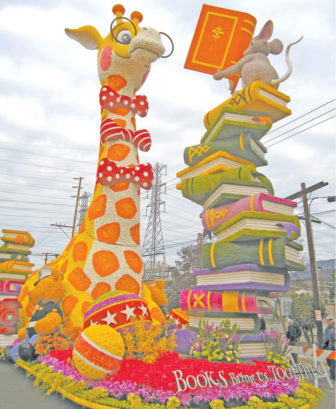
Photo by Johanne Presser
The UPS float for the Rose Bowl Parade, “Books Bring us TOGETHER,” features Geoffrey the Toys “R” Us giraffe.
Although I always thought I was too young to have a bucket list, the arrival of my first Social Security check taught me otherwise. I started to think of things I would like to do before I hit the nursing home. Tops on my list was going to the Rose Bowl Parade or, as the parade organizers like to call it, “America’s New Year Celebration”. Conveniently, a Roads Scholar brochure I came across had a Rose Bowl trip which included working on a float, attendance at various parade activities and lectures from experts about the history of the parade, its participants and the process involved in putting on the event. Two of my friends signed on with me and on December 29, we were off to California.
The first thing I learned was that it is not always warm in Southern California and, notwithstanding a five year drought, it does rain. At the first day’s orientation participants were divided into groups and given a float assignment for the next day. We learned that the average cost to design and construct a float (which is almost a year long process using primarily volunteer labor) is $275K with this year’s floats ranging in cost from $75K to over $400K. Every inch of the float must be covered in a natural material of either flowers, seeds, or bark and no artificial dyes are allowed. The floats are built on a motorized chassis using steel and chicken wire. A polyvinyl material is hosed onto the structure and painted in colors where the proper flowers are to be applied later. It is estimated that the average float uses more flowers than the average florist will use in five years. Companies submit bids and designs in keeping with the parade’s theme as early as three weeks after the previous Rose Parade has ended.
Our venue was in charge of five different floats including the rather mundane ones of Penn State and USC, the two teams playing in the Rose Bowl. The other three, however: Netflix, China Airlines, and LA 24 Fitness, each won one of the 24 official honors bestowed.
The event itself (not including float decorating) requires over 80,000 hours of manpower which is supplied by 935 members (volunteers) of the nonprofit Tournament of Roses Association. It is considered very prestigious to be a volunteer and one must wait until there is an opening. Each volunteer is assigned to 1 of 31 committees rotating to a different one each year. The president of the Association serves one year and is responsible for selecting the Parade theme and the grand marshals. Presidents are selected seven years in advance. This year’s theme was “Echoes of Success” and the grand marshals were past Olympians Greg Louganis, Janet Evans, and Allyson Felix.
This year, in addition to the 41 floats, there were 20 equestrian units and 21 marching bands. Also this year, the parade was moved to Monday, January 2, in keeping with the “Never on Sunday” requirement. This restriction goes back to 1893, the first time since the parade began that January 1 fell on a Sunday. It was moved to the next day so that the parade would not spook the horses that were hitched outside churches along the route thereby disturbing worship services.
Our work on the floats was definitely unskilled but necessary. It involved cutting roses at an angle and inserting them in those water tubes which would then be placed into the polyfoam, applying glue to spongy material shapes and covering them with statice, wiring baby’s breath into nosegays and plucking petals from red carnations to glue onto shapes.
In addition to working on the floats, we attended Bandfest, which featured performances by eight of the marching bands. Unfortunately, it started to rain half way through the performance, which put a damper on the festivities, but the bands gamely played on. The other unfortunate situation this year was that the Equinefest, which features horse group performances, was called off due to an equine virus that was going around. We also heard from a rose expert and former judge about what criteria are used in judging the floats. Each float gets looked at for five minutes on two separate occasions on the day before the parade.
The parade itself was amazing. At 5 a.m. the morning BEFORE the parade, people can save up to ten spots but someone has to be there the whole time. Many camp out and we saw many tents, sleeping bags, hibachis and grills along the way to our bleacher seats. The five mile parade starts with a stealth bomber flying overhead at 8 a.m. and lasts for over two hours. Ironically, a float that portrayed the tortoise and the hare’s race and had “never give up” spelled out in rose petals, conked out about ½ mile before the race’s end and had to be towed off the route.
Perhaps even better than the parade was the post parade viewing of the floats. For a small fee you can view all the floats close up and admire the detail that goes into them.
There were so many beautiful and creative floats that it is very difficult to pick my favorite. If forced to choose I would have to say my top three were the Lucy Pet float that had a 55 foot water tank with live surfing dogs, the UPS “Books Bring Us Together” and the “Home Tweet Home” which had birds building new homes for themselves.